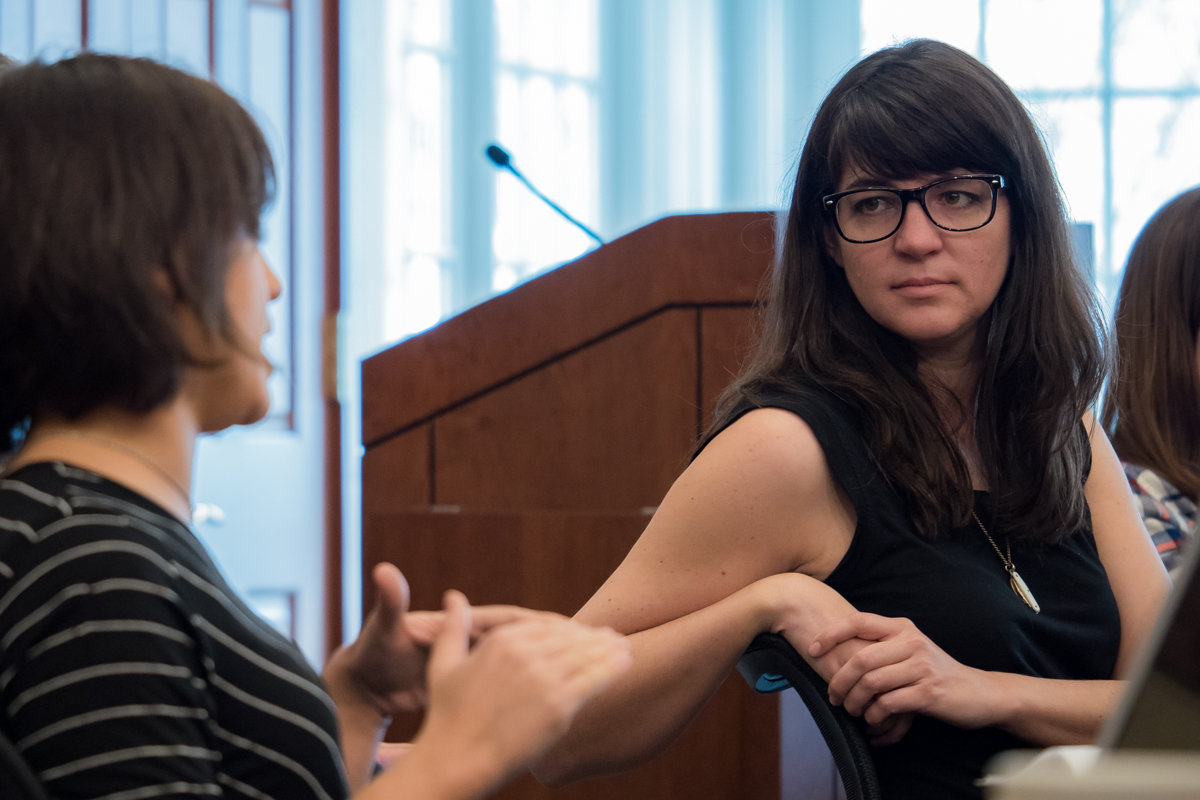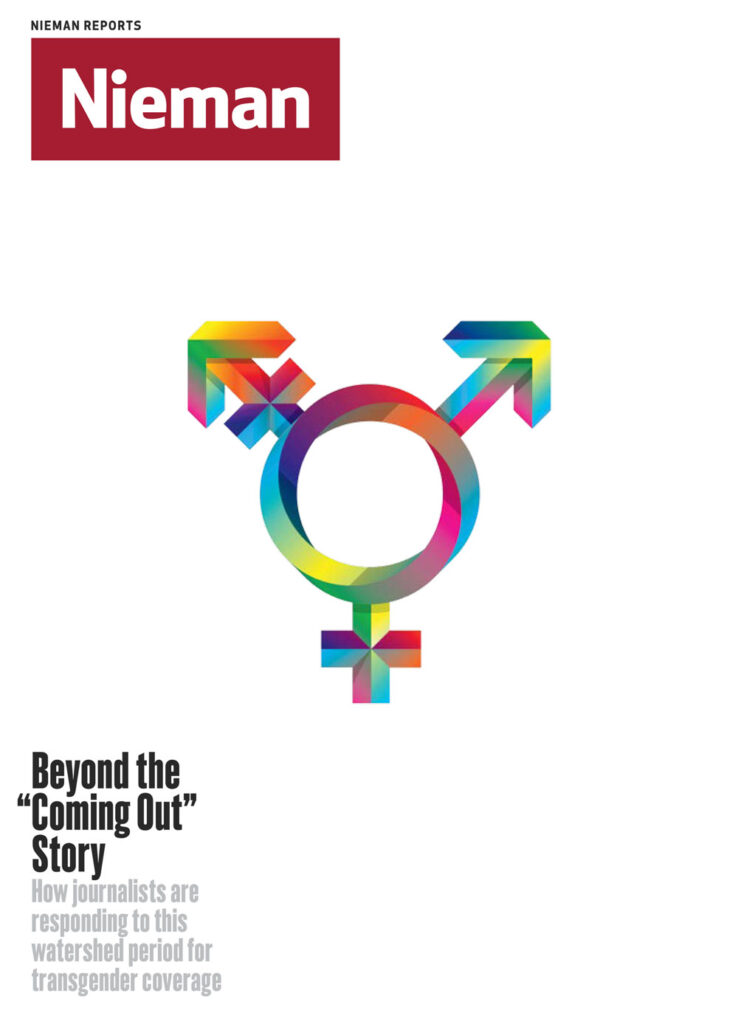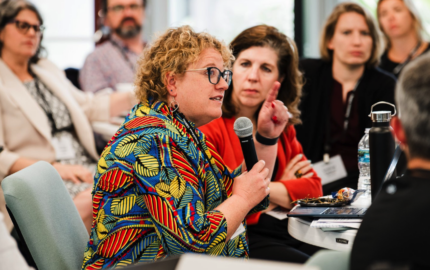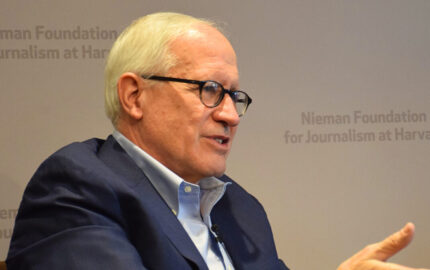Melissa Bell is a journalist, technologist, and co-founder in 2014 of Vox.com, a site focused on explainer journalism. In 2015, she assumed a corporate role at parent company Vox Media. As vice president of growth and analytics, she oversees strategy not only for Vox.com but for tech sites Re/code and The Verge as well as sites that focus on sports, gaming, real estate, food, and fashion: SB Nation, Polygon, Curbed, Eater, and Racked. In October, Vox Media topped 60 million unique monthly visitors, according to comScore, not far off The New York Times digital site and Bell’s former employer, The Washington Post, where she was director of platforms.
Bell spoke with Nieman Reports during a visit to the Nieman Foundation in December. Edited excerpts:
On Learning from Walt Disney
The benefit of building a brand that audiences recognize will, in the end, allow us to continue to build a strong revenue model and a strong connection to an audience. If they see us on Snapchat and Snapchat has a very large audience, then they get to know and trust Vox and see it as a source that they care about. If 10 percent of that audience finds us on YouTube, five percent finds us on Facebook, and two percent finds us on Twitter, that’s great. There’s a revenue opportunity with Snapchat, and we can use that to support the journalism that we’re doing elsewhere. You have to think about your brand as an interconnected ethos that should exist in multiple places.
Walt Disney had an interesting idea about how his brands supported each other. The theme parks came from the movies; the movies came from his animations. The merchandise allowed for stores to be built. Some of the rides have become movies. Movies have influenced the rides. They all rely on each other. I think about that when I’m thinking about our newsroom.
Our Snapchat stories are inspired by the articles that we write on Vox.com. Our videos are inspired by the articles we run on Vox.com. Sometimes our videos are turned into graphics; sometimes the graphics are built into longer form pieces.
On Collaboration
There has to be a spirit of collaboration and a sense of shared responsibility at a media company. A writer who writes articles for Vox.com has to know that we also want them to be an owner of our video success so that they are invested in that project just as much as they are in their own articles.
However, there also has to be some freedom and independence for these groups to do the work they need to do on the different platforms. Our Snapchat team is going to own the way we present news on Snapchat, and if they do a story that doesn’t exist anywhere else, that’s fine.
There has to be a spirit of collaboration. However, there also has to be freedom for groups to do their work
On Newsroom Diversity
Diversity has to be a recognized responsibility of everyone at the company. I feel very encouraged and excited about our work on diversity at Vox.com in particular and at Vox Media overall, because it wasn’t me just shouting into the wind. It is a true effort pushed by [Vox.com co-founders] Ezra Klein and Matt Yglesias, who are both white men. They made it as much of their responsibility as I felt like it was a responsibility of mine.
We’ve created a leadership team that is working on diversity at our company, and you need to have white men on that team. You need to have them invested in it. You need to have a constant conversation about this topic. There’s no moment that you can say, “All right, good job, we’ve succeeded, we’ve created an inclusive workplace and we’ve gotten some great talent in the door. We’re done.”
It matters every single day—in terms of how you’re thinking about career development and your internship program. It matters every single time you post a job listing. It matters in how you’re setting up meetings and how you’re thinking about whether or not you have the right people in the room.
On Building a Culture
People always go back to the fact that we are using a custom content management system called Chorus. This is going to sound a little Mr. Rogers-esque, but one of the things that has allowed us to do such great work is the culture that we’ve built and not so much the platform that we’ve built.
The platform is a great technology product, but it’s the team that’s doing the work on it that matters most. It’s also the ability to say we need to get this company to change quickly and to be on the same page about the direction.
We had to do this when the Facebook Instant Articles, Google Accelerated Mobile Pages, Apple News projects spun up; that was work that was not on our core platform. We had to say: This is something we’re going to invest in. We had to be able to articulate that to 540 people.
Not everyone needs to know all of the details of why we’re doing it, but the people who did need to know were able to make the shift, get the work done, and be fast about it. I think that is a benefit we have. I think that the high-quality design of our sites, for instance, is because we’ve created a rich culture of respect for design and valuing the visual representations.
Again, it all comes down to people pushing for a shared ownership. It’s not just that we have a design group over in a corner that works on our design. It’s that design is something that we all think about and care about deeply, and so it’s able to affect all of our sites in a productive way.
On Improving the Ad Experience
I think ad blocking is a symptom of the larger disease of advertising in the digital space. In the past, we, as a media industry and as an online advertising industry, did a huge disservice to users by not creating a better advertising experience online.
We didn’t try to innovate. This comes up with the constant conversation around banner ads. The banner ad existed for 20 years with the only real iterations being, “How do we make it more annoying” not “How do we make it better.” You got pop-outs and you got noise and takeovers and all of these things. That did a real disservice to us.
You see in other industries that there can be advertising-supported business models. You look at this with Vogue magazine, where there’s some high-end beautiful advertising in the book. I think a lot of people who buy Vogue care about those ads; they don’t feel like it distracts from the great journalism that Vogue does, but supports the 900-page September issue.
At Vox Media we are thinking about how to improve the advertising experience. We are also willing to risk losing some revenue on the chance that we can create a better experience. That is something that I think we really need to do in digital media. We’re not going to solve this overnight.
The banner ad existed for 20 years with the only real iterations being, “How do we make it more annoying” not “How do we make it better”
On Snapchat
Allison Rockey, our director of programming at Vox.com, has inculcated in us the idea that you need to take the underlying ethos of what Vox.com is and create the storytelling format that is native to the platform.
When we work on Vox.com, we think about the longer story arc. What is the news? The news is never new; it’s something that’s been—there’s context to it, there’s history to it, there’s a reason why we’re at the place we’re at today.
We need to be thoughtful about what are those bigger story arcs. That’s one theme at Vox.com. Another theme is beautiful visuals, thoughtful, stunning graphs, and smart motion graphics. Another thing that we want to do, obviously, is explain.
When you take those three things together, the way that the team looked at Snapchat was: The Snapchat format is visual first, because it’s on a small screen on your phone. It allows for sound, visuals, and text. Most users take a photograph and write text over it, or do a short film with text over it.
When our people started thinking about how to develop a format for Snapchat, they started to think about 10-second motion graphics with some text written on them. They decided to use Snapchat’s swipe characteristic so you could tell a story through multiple swipes.
They also decided to tackle a bigger subject. One recent one was Islamophobia. There’s a number of ways to cover or tell the story of Islamophobia in America. You could do it through a graph, or you can do it through a story around Donald Trump. You can get at it through different angles. Each Snap we think about is like a different angle of this larger topic.
When I read these Snapchat stories, I walk away with a deep understanding of the topic. I feel informed. What we’re seeing from our readers is that they also feel that way and that they’re excited about this. That, to me, is the key goal.
What I’ve always hoped that we could do is give people the start of understanding, so they’ll be encouraged to discover more about it later on. Perhaps you look at the Islamophobia story on Snapchat and then you hear about it in a class or you see a news story about it. You have a basis of knowledge around it, so then you can start to participate in the conversation and learn more about it. I love to think about those stories as a gateway into knowledge.




